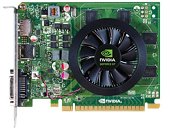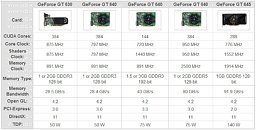Wednesday, April 25th 2012

NVIDIA Releases GK107-based GT 630, GT 645 and 3 GT 640 Variants to OEMs
NVIDIA released its first desktop graphics cards based on its 28 nm GK107 silicon, in as many as three models, the GeForce GT 630, GT 640, GT 640 (second variant). Apart from these, NVIDIA appears to have launched two more models, one labeled GT 640, and another GT 645, which are based on previous generation GF116 and GF114, respectively. These new SKUs are available only to OEM partners, who will implement them in their new desktop PC designs.
Of the five new SKUs, the GT 630 and GT 640 (28 nm) are most interesting, as they are based on the GK107 silicon, with as many as 384 CUDA cores, and TDP as low as 50W. The GT 630 is a single-slot, low-profile graphics card with 384 CUDA cores, and a 128-bit wide GDDR5 memory interface, 875 MHz GPU clock speed, and 891 MHz memory clock speed. The GT 640 (28 nm) features different clock speeds. The specifications may seem confusing to the end user, but then they really don't concern people who buy retail-channel graphics cards. NVIDIA and AMD design OEM-specific SKUs completely à la carte, to OEM partners' requirements.
Source:
VideoCardz
Of the five new SKUs, the GT 630 and GT 640 (28 nm) are most interesting, as they are based on the GK107 silicon, with as many as 384 CUDA cores, and TDP as low as 50W. The GT 630 is a single-slot, low-profile graphics card with 384 CUDA cores, and a 128-bit wide GDDR5 memory interface, 875 MHz GPU clock speed, and 891 MHz memory clock speed. The GT 640 (28 nm) features different clock speeds. The specifications may seem confusing to the end user, but then they really don't concern people who buy retail-channel graphics cards. NVIDIA and AMD design OEM-specific SKUs completely à la carte, to OEM partners' requirements.


20 Comments on NVIDIA Releases GK107-based GT 630, GT 645 and 3 GT 640 Variants to OEMs
THE OTHERS MORE CODA BUT ONLY 128 MEMORY :shadedshu
Also, you might want to TURN OFF your damn caps lock key... :shadedshu
While 3 different GT 640's with totally different spec's, that's just super confusing? Probably slated to help clear SB systems so OEM’s can say GT640 "Kepler Equipped" (which translate to not the level of a GT 240 DDR5) for that first one. Then that second one feels more like a GT440... low Cuda count, while the double shader clock is telling, hooped-up on 192-bit bus, with a lower clock but still 75W (see it)? That's the one to allow OEM to pull the "old switcheroo" and stick unsuspecting folks with the "640 moniker" (a Fermi based GF108) for a little less cash.
The last two... that other 640 seems like another Kepler (like the first) just OC’d enacting on the 75W TDP and probably not anywhere as good as the 7750. The GT650 appears to be more a GTX560 that’s really castrated to the point of being like either a GTS450 or and GTX550 in true performance... so pass on that.
On a side note, I wish they'd do something to distinguish which cards are Fermi and which are the new core... like, 640GTS or 640SE would be nice, then again the separate shader clocks kinda gives it away, but still its a bit confusing.
also, why does the low profile 630 have a higher clock speed than the "low end" 640? even though the rest of the specs are the same, shouldn't it be the other way around... starting to have doubts about the source's chart
more barmy nameing though , wont matter as ill never see one, id have the 645 though;) better cuda performance id wager(physx hmm).
on the whole ,cant be bad surely more will follow soon
While yes both do it, the 6770 and HD 6750 examples you provided is not nearly as baffling, just straightforward renaming. No bewildering new spec’s without an indication of chip process that’s used. Even when AMD released the 7670, 7570... OEM’s they were simply re-releasing the existing spec's on 40Nm, not the perplexing mix this Nvidia stuff is.
www.techpowerup.com/158169/More-AMD-Radeon-HD-7000-OEM-Products-Surface.html
My hope someday in future someone thinking of some OEM pre-built with these will be searching… needing information. This might help some as it’s almost always artful how little information out there for such oddities. Causing most novices buyer disillusionment over such a purchase, there’s a chance this might help them. :D
OEM's are still likely confusing just as many people by selling HD 7650M's (a HD 6650M with lower core/shader clocks), or the more convoluted asymetrical crossfire. Can't say I know too many people (OEM buyers or not) that can figure out performance and naming conventions behind such "SKU"'s as HD 6740G2 (It's a discrete HD 6650M + APU 6620G if you were wondering). In the perplexing mix hierachy where do you suppose asymetrical crossfire naming conventions fall?Sounds like a pipe dream crossed with an episode of Kung Fu to me. Most people I know who have purchased pre-builds generally ask no more questions than the salesperson in front of them is willing to answer, and the most in-depth questions asked are "How much is it?", "Can I watch You Tube on it?", "Is the webcam extra?", "How much RAM does the harddrive have?" and "My friend has a Mac, he says it's better than this...is it true?"Mmmm, there's a whole internets worth of information out there, including more GPU review and database sitesthan you can shake a stick at. Your basic premise is that an OEM buyer will research a possible purchase before doing so- my experience is that an OEM buyer starts looking for information only after something fubars...and the information required has less to do with GPU microarchitecture than it does getting rid of malware and toolbars after a late night porn surf. YMMV of course.
:D:toast: